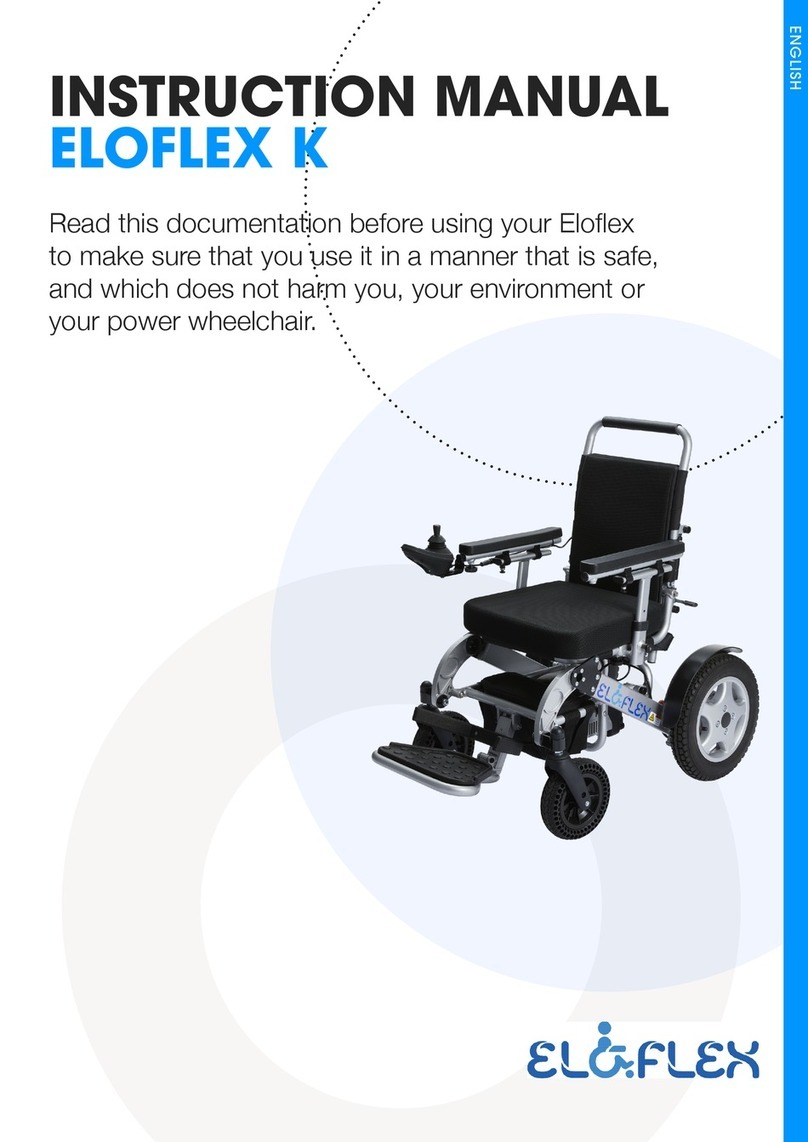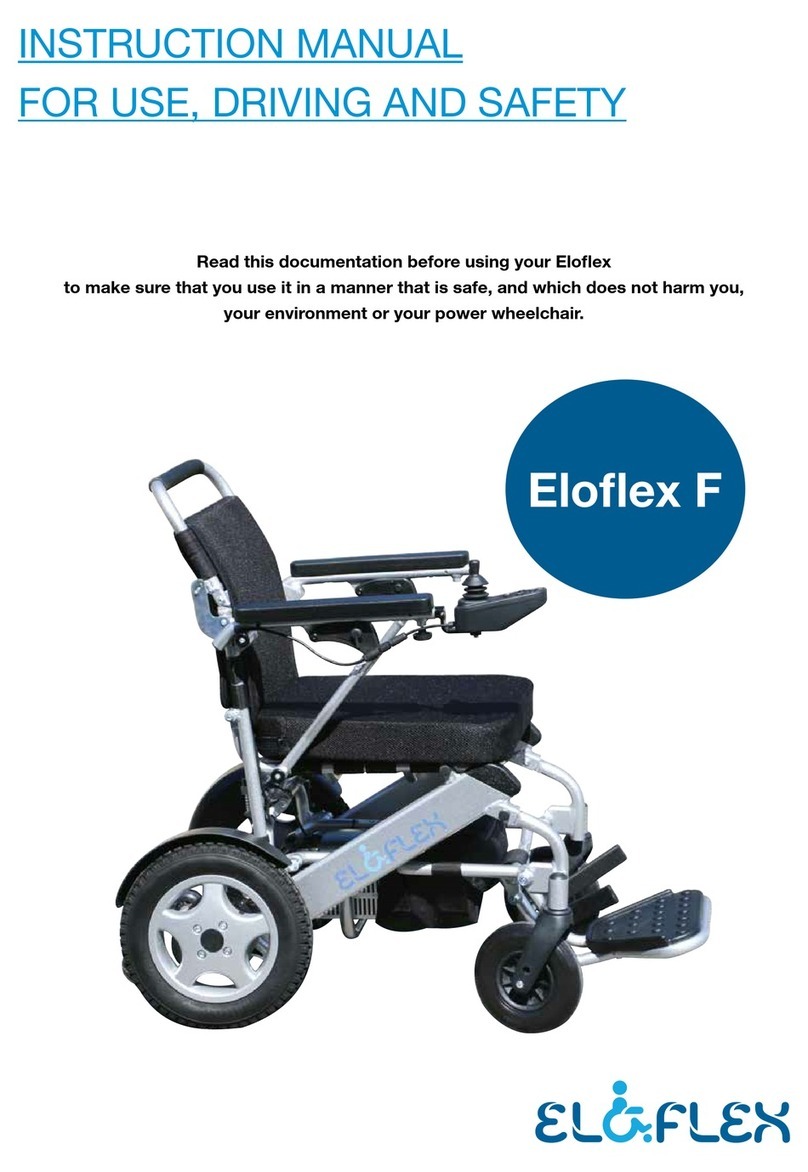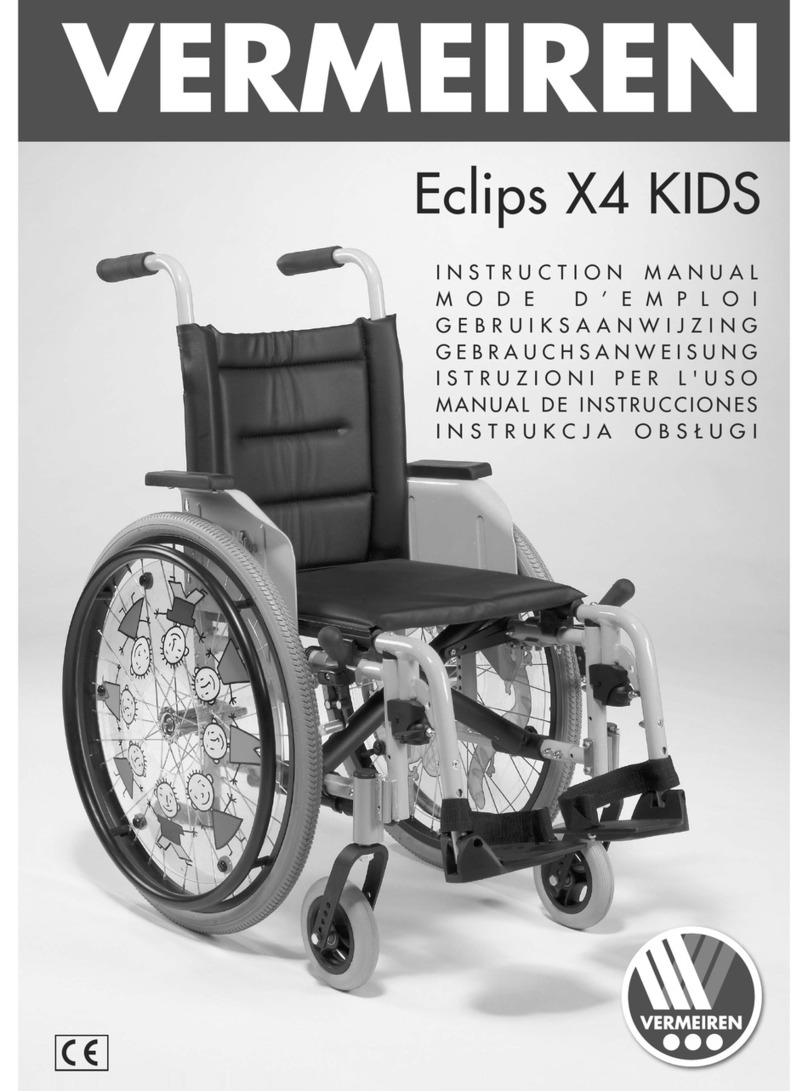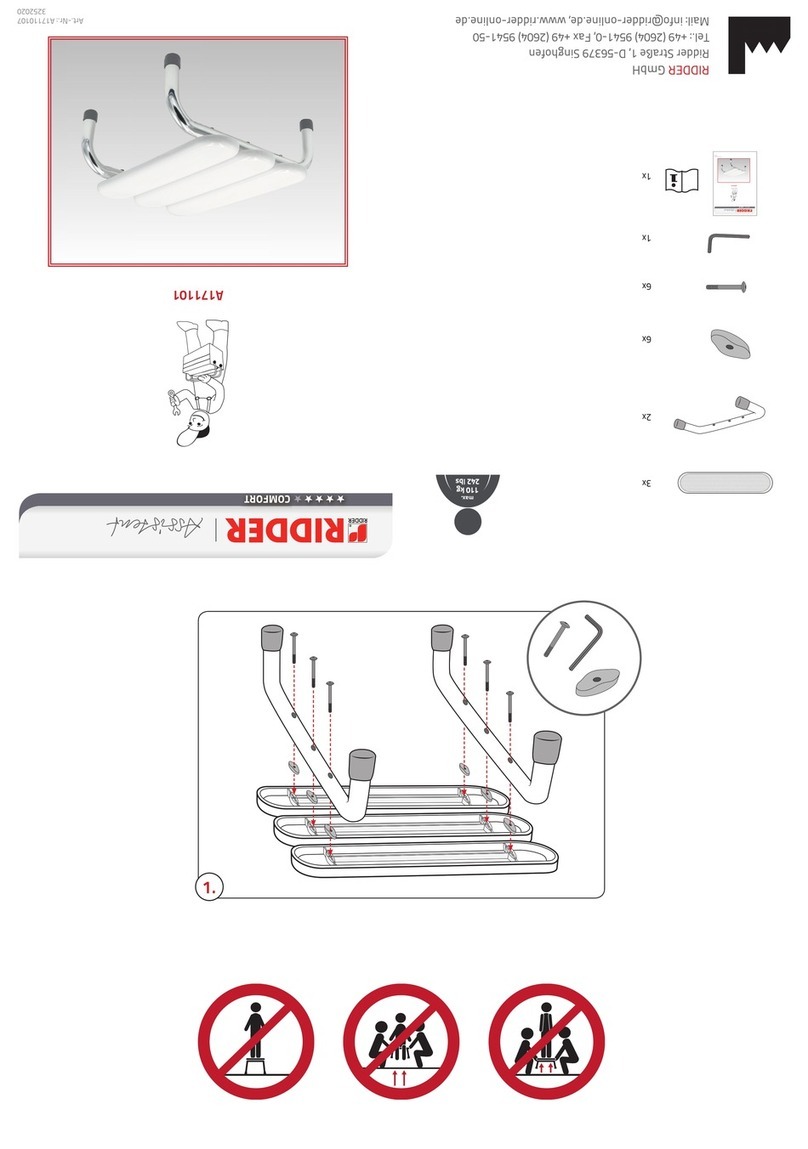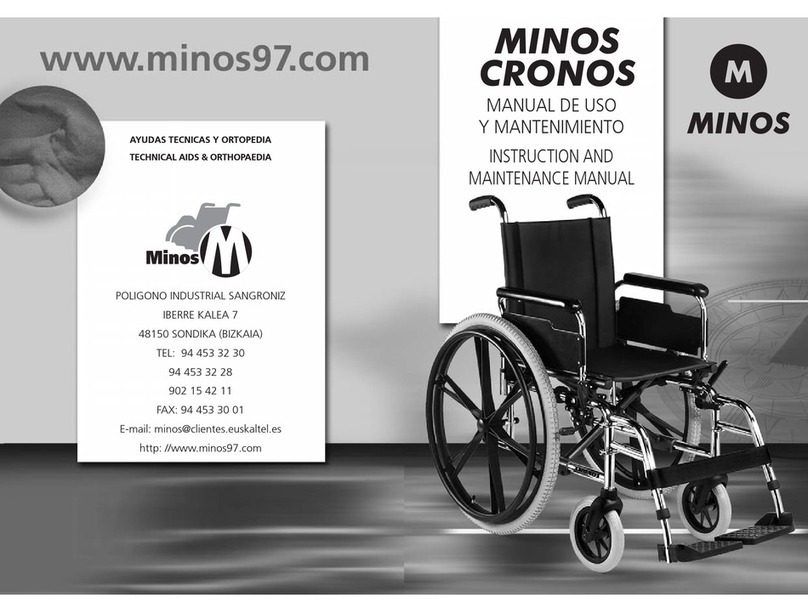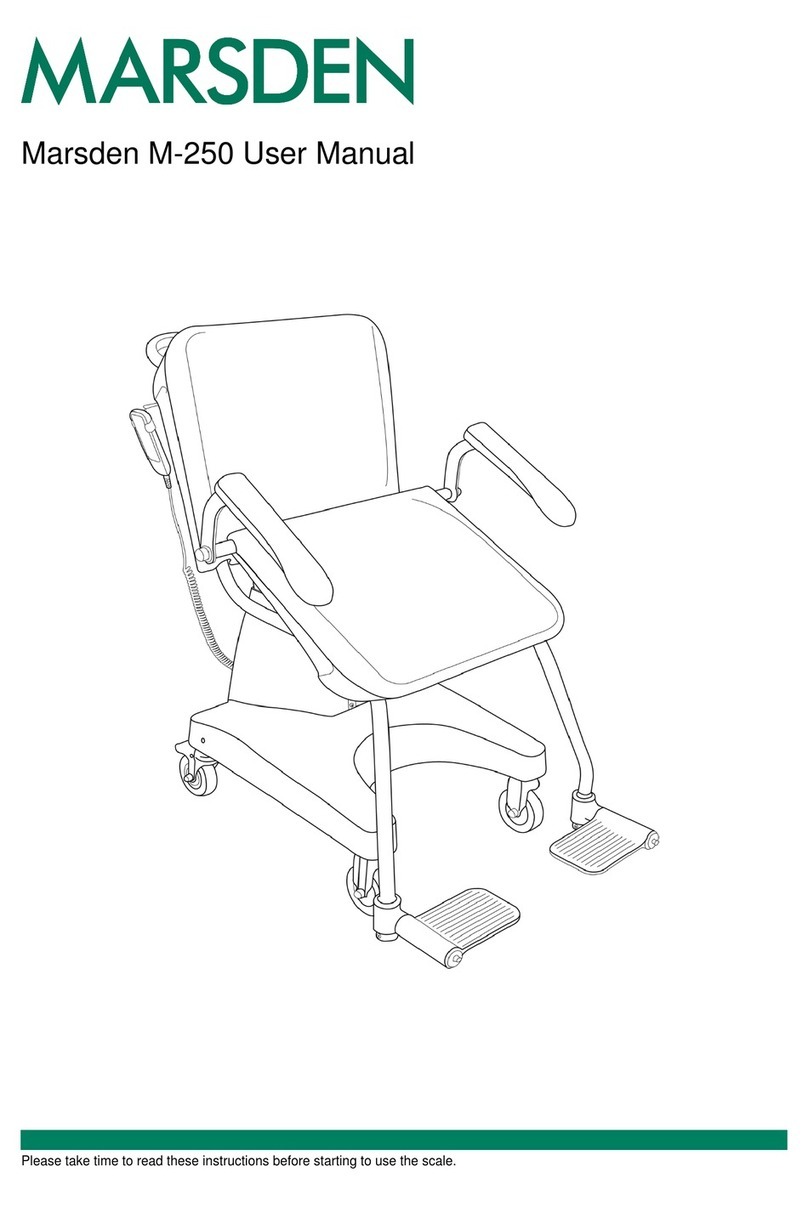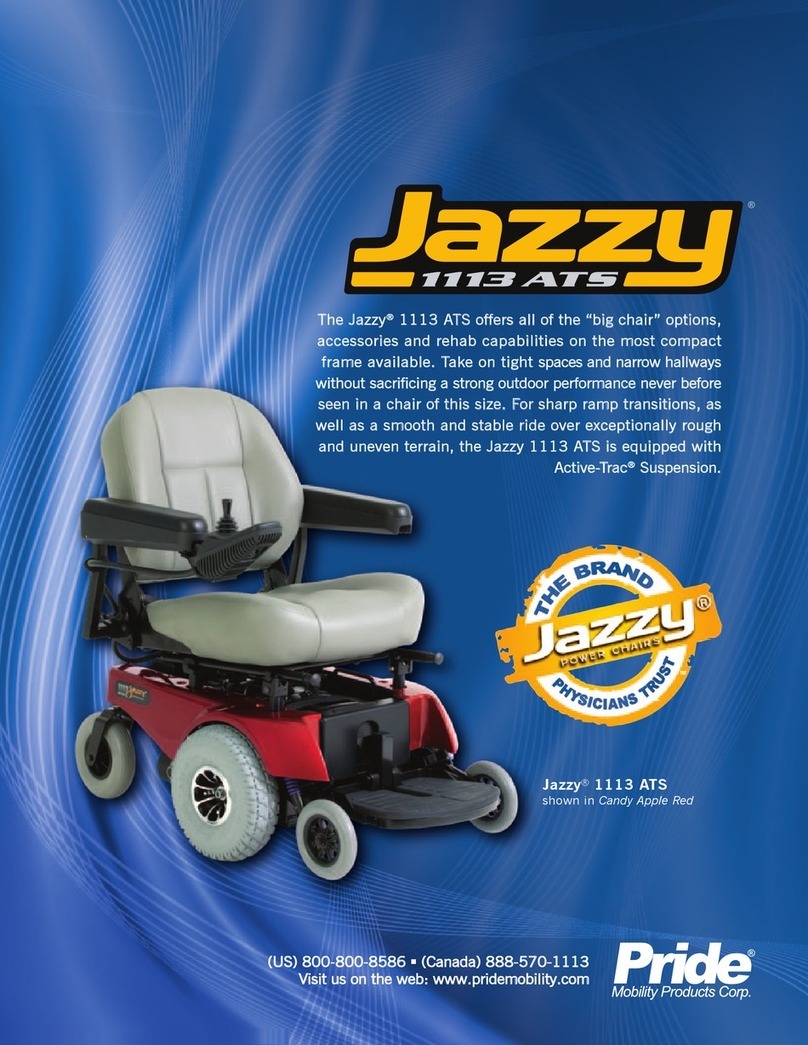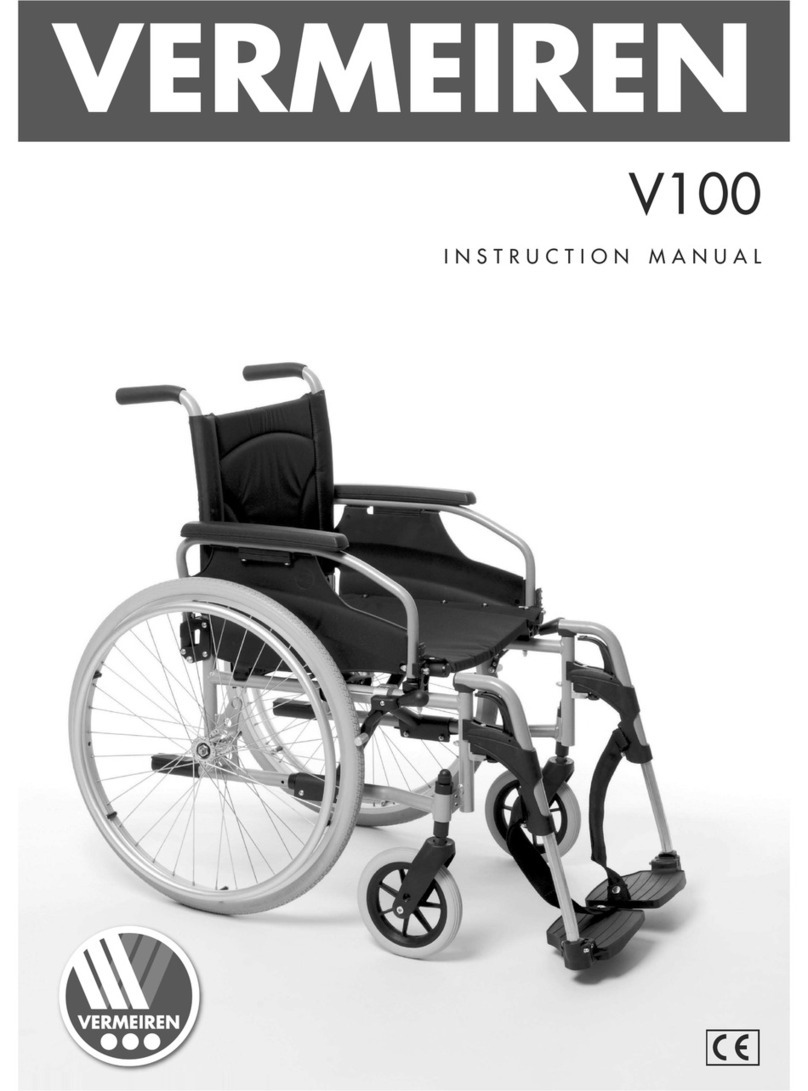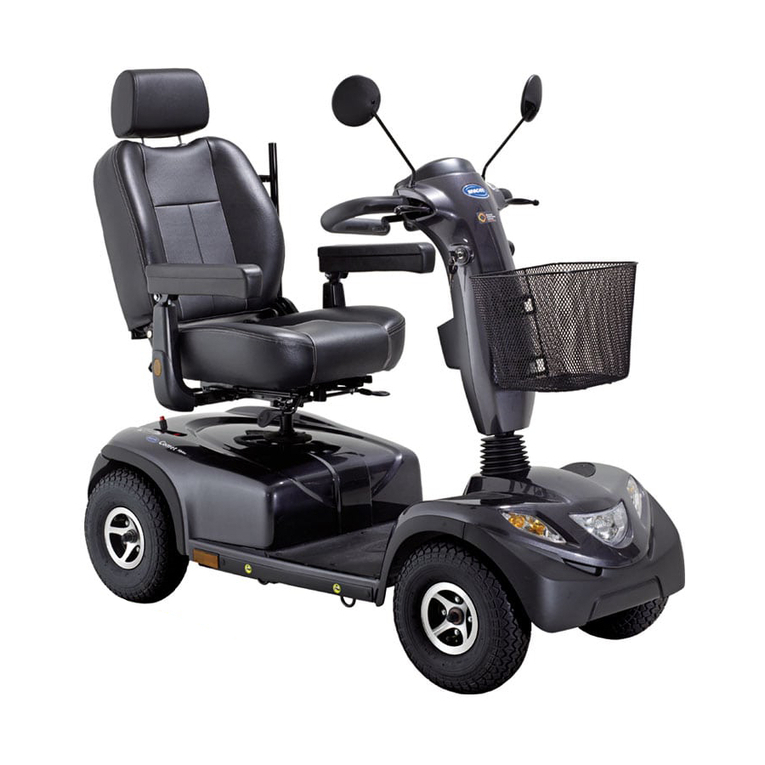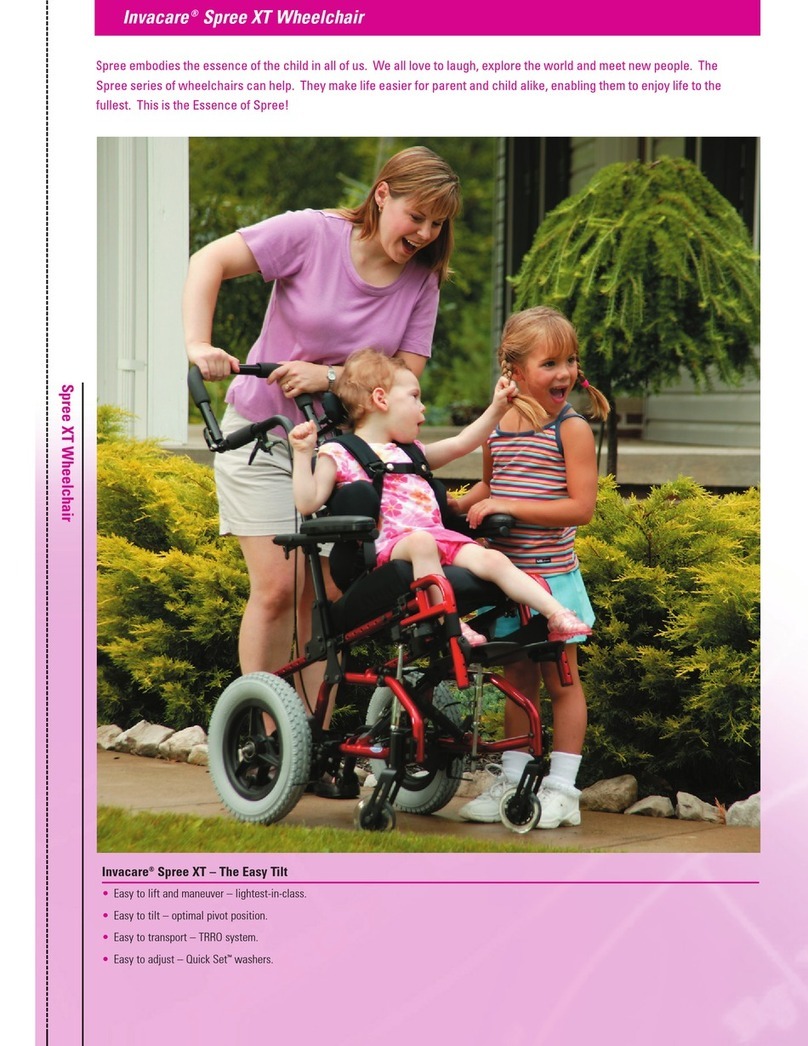Eloflex C User manual

OWNER’S MANUAL
POWER WHEELCHAIR
Eloflex
C

Thanks and Good Luck!
Thank you for choosing an Eloflex as your electric powered wheelchair. It means a lot to us because our vision is
to make people’s everyday life a little easier, and to give people with disabilities a greater freedom. We hope you
experience both with the help of your Eloflex.
This manual contains important information on safety, use and care. We encourage you to read through this entire documentation
before using your Eloflex for the first time. We also suggest that you train to run your Eloflex on a secluded, open and level surface
before using it in other contexts. This power wheelchair is suitable for people who have difficulty walking or cannot walk at all, but
who have vision ability, physical ability and mental ability to contol a power wheelchair.
The power wheelchair is of outdoor type, suitable for the use indoor and flat path near buildings, but not on grass, gravel roads, large
slopes or motorway, and also not in snow.
Eloflex power wheelchair is designed for users with many different needs. The decision whether Eloflex is suitable for the user is
always taken by the ordinator or dealer together with the user herself/himself. Eloflex accepts no responsibility for cases where the
power wheelchair is not adapted to the user’s needs.
To use your product safely depends on whether you strictly follow the warnings, attentions and operating instructions in this manual.
The company shall not be responsible for any injury or damage caused by non-compliance with the warnings, attentions and
operating instructions. These symbols below in this manual are used to identify warnings and important information. All of them are
very important to your safety. It is strongly recommended that you should read and understand them completely.
Drive carefully!
Warning! Failure to heed the warnings in
the manual may result in personal injury.
Attention! Failure to heed the attentions in
the manual may result in damage to the
wheelchair.
!
x
Content Page
Intended use 1
Precations for safe use 2
Performance and structure 7
Assembling and unfolding 9
Joystick installation and adjusting 10
Anti-tipper instruction 10
Adjusting brake lever 10
Adjusting armrest 11
Folding 12
Use and operation 13
Battery and charger 15
Fault analysis and troubleshooting 16
Maintenance and repair 17
Technical specifications 18
Contact 18

Type classification and intended use
Eloflex power wheelchairs have been developed for people
who have difficulty walking or cannot walk at all, but who
have vision ability, physical ability and mental ability to control
an power wheelchair.
The Eloflex power wheelchair is sufficiently compact and
flexible for indoor use, but the chair is also suitable for
outdoor use. The chapter ”Technical data” at the back of this
document contains information on speed, turning radius,
range, maximum lifting capacity and maximum weight for
the user and so on. We encourage you to read all safety
information in the chapter ”Precautions for safe use” in this
document.
Eloflex is tested and approved according to EN12184: 2014
- class B (indoor and outdoor use). Eloflex is also approved
according to ISO-7176, IEC60601 and the batteries are
approved according to UN38.3.
Eloflex power wheelchairs meet the applicable requirements
of the MDR 2017/745.
Class 1 conformity assessment / CE marking has been
issued in accordance with Annex VIII Chapter III of MDR
2017/745. Conformity assessment procedure: Annex II and
Annex III of MDR 2017/745.The CE marking will be void if you
use replacement components or accessories that have not
been approved for this product.
Needs
The purpose of an Eloflex power wheelchair is to
compensate for an injury or disability, which is why it is
recommended in the following circumstances:
• If the user has the inability to walk or very limited ability
to walk, which makes it difficult to move in his / her own
home.
• If there is a need to leave the home to get out or to visit
places that are normally visited in order to carry out everyday
affairs.
• When the user has difficulty getting to, or performing work
or activities because of his / her mobility disabilities.
It is advisable to use Eloflex power wheelchairs both indoors
and outdoors, if it is not possible to use hand-operated
wheelchairs due to mobility problems, but it is still possible to
properly handle power wheelchairs.
Utility
Only use the Eloflex power wheelchair when fully functional.
Otherwise you put yourself and others at risk. The following
list does not include all possible situations. It describes only
certain situations that may affect the usability of the power
wheelchair.
• Do not use the power wheelchair if the batteries are
defective or deformed.
• Do not use the power wheelchair if the engine is jerky or
makes abnormal noise.
• Do not use the power wheelchair if the brake function
appears to be wrong.
• If your tires are worn, contact your assistant center or
dealer.
• If you notice any damage to the seat belt, armrest, seat,
backrest, joystick or other part of the chair, contact your
assistant center or dealer.
• If you notice any damage to the electrical system (cables,
batteries, chargers, etc.), please contact your assistant
center or dealer.
Warranty
You always have a two-year warranty on your Eloflex power
wheelchair. The warranty conditions are in line with the
applicable national and general terms and conditions and
rules and regulations. The detailed warranty conditions can
be downloaded at www.eloflex.eu. Note that you should save
the original carton for your Eloflex during the warranty period
(the carton can be folded together and set aside).
Life span
The estimated lifetime of an Eloflex is 5 years. However, the
life of the product is largely affected by how it is used and
managed. An Eloflex can have a much longer life if you take
care of it in a good way and only use it in line with the
information in this document.
Safety regulations and risks
PLEASE READ THE SAFETY INSTRUCTIONS FROM THE
PAGE 2-6 BEFORE YOU USE YOUR ELOFLEX.
Intended Use
1

Expiration date
This power wheelchair is an electrical, non-asepsis
and reusable product. The safe and period of validity
for wheelchair on the clinical use not only depends on
its structural strength, but also on the user’s utilization,
environment, whether in accordance with the periodic
maintenance, and other factors. Our products have an
estimated lifetime of 5 years.
Instructions before use
• If you not completely read and understand the user
manual, please do not drive.
• The maximum loading capacity is shown in the
parameter table for technical features. Please do not
overload driving. And it is single use, please do not carry
passengers.
• Please do not drive after alcohol intake or when you are
too tired.
• Please do not drive at night or in the case of an unclear
line of sight.
• Please self-check before driving and refer to the manual
section ”adjusting” and ”Practice before operation” if
driving for the first time.
Attention in use
• This power wheelchair can drive on a good flat surface;
do not drive on muddy, rugged, soft, narrow, icy road,
bad roads such as dangerous roads without guardrails
or waterways.
• This power wheelchair has the certain ability of groove
obstacle, at this time you should reduce the speed and
travel slowly.
• This power wheelchair has the certain climbing ability, the
climbing angle is≥6, but no more than 10°.
• Please avoid driving in the crowds, traffic flows and other
places with heavy traffic.
• Please ensure that the control system is firmly installed,
the joystick is vertical, correctly positioned. Please sit
well and buckle up in time, keep your head as back as
possible, lean against the backrest in case out of control
due to the dump.
• Press the on/off button, firstly check if the current fastest
speed setting is appropriate for yourself operating
proficiency, or it should be adjusted for safety;
• We recommend to drive slowly at the beginning for each
use, and gradually accelerate.
Electromagnetic interference (EMI)
Electromagnetic interference is from external electromagnetic
wave energy (like radios, TV transmission stations, CB
radio waves, and garage door starters, radio phones, etc.).
Electromagnetic interference may affect the control system
of the power wheelchair. Some interference may lead to the
brake failure, power on automatically, or steering failure, also
may lead to the permanent damages to the control systems.
Below cables information are provided for EMC reference.
Cable Max. cable length,
Shielded/unshielded
Number Cable
classification
AC Power
Line
1.8m shielded 1 Set AC Power
DC Power
Line
1.2m shielded 1 Set DC Power
This electrical medical equipment needs special precautions
regarding EMC and put into service according to the EMC
information provided in the user manual; The equipment
conforms to this IEC 60601-1-2:2014 standard for both
immunity and emissions. Nevertheless, special precautions
need to be observed: The equipment with ESSENTIAL
PERFORMANCE/Following ESSENTIAL PERFORMANCE is
intended used in home healthcare environment.
Essential performance
The power wheelchair can work normally without moving out
of control, and the speed change is not more than ± 20%.
WARNING: Use of this equipment adjacent to or stacked with
other equipment should be avoided because it could result in
improper operation. If such use is necessary, this equipment
and the other equipment should be observed to verify that
they are operating normally”.
The use of accessories, transducers and cables other
than those specified or provided by the manufacturer of
this equipment could result in increased electromagnetic
emissions or decreased electromagnetic immunity of this
equipment and result in improper operation.
WARNING: Portable RF communications equipment
(including peripherals such as antenna cables and external
antennas) should be used no closer than 30 cm (12 inches)
to any part of the W5907, including cables specified by the
manufacturer. Otherwise, degradation of the performance of
this equipment could result.”
WARNING: If the use location is near (e.g. less than 1.5 km
from) AM, FM or TV broadcast antennas, before using this
Precautions for Safe Use
2

equipment, it should be observed to verify that it is operating
normally to assure that the equipment remains safe with
regard to electromagnetic disturbances throughout the
expected service life.
When the AC input voltage is interrupted, the equipment
will stop battery charging and if the power supply restored,
it could be recovered automatically, this degradation could
be accepted because it will not lead to unacceptable risks
and it will not result in the loss of basic safety or essential
performance.
EMI Compliance Table (Table 1)
Table 1 - Emission
EMS Compliance Table (Table 2-5)
Table 2 - Enclosure Port
Phenomenon Basic EMC
standard
Immunity test levels
Home healthcare
environment
Electrostatic
Dis-charge
IEC 61000-4-2 ±8 kV contact
±2kV, ±4kV,
±8kV, ±15kV air
Radiated RF EM
field
IEC 61000-4-3
20V/m
26MHz-2.5GHz
80% AM at 1kHz
10V/m
80MHz-2.7GHz
80% AM at 1kHz
Proximity fields
from RF wireless
communications
equipment
IEC 61000-4-3 Refer to table 3
Rated power fre-
quency magnetic
fields
IEC 61000-4-8
30A/m
50Hz or 60Hz
Table 3 – Proximity fields from RF wireless
communications equipment
Test
frequency
(MHz)
Band
(MHz)
Immunity test levels
Home healthcare environment
385 380-390 Pulse modulation 18Hz, 27V/m
450 430-470 FM, ±5kHz deviation, 1kHz sine, 28V/m
710 704-787 Pulse modulation 217Hz, 9V/m
745
780
810 800-960 Pulse modulation 18Hz, 28V/m
870
930
1720 1700-
1990
Pulse modulation 217Hz, 28V/m
1845
1970
2450 2400-
2570
Pulse modulation 217Hz, 28V/m
5240 5100-
5800
Pulse modulation 217Hz, 9V/m
5500
5785
Table 4 – Input a.c. power port
Phenomenon Basic EMC
standard
Immunity test levels
Home healthcare environment
Electrical fast
tran-sients/burst
IEC 61000-4-4 ±2 kV
100kHz repetition frequency
Surges Line-to-line IEC 61000-4-5 ±0.5 kV, ±1 kV
Conducted
disturb-ances
induced by RF fields
IEC 61000-4-6
3V, 0.15MHz-80MHz
6V in ISM bands and am-
ateur radio bands between
0.15MHz and 80MHz
80%AM at 1kHz
Voltage dips
IEC 61000-4-11
0% UT; 0.5 cycle
At 0º, 45º, 90º, 135º, 180º,
225º, 270º
and 315º
0% UT; 1 cycle and
70% UT; 25/30 cycles Single
phase: at 0º
Voltage interruptions IEC 61000-4-11 0% UT; 250/300 cycles
UT=rated input voltage
Table 5 – Signal input/output parts port
Phenomenon Basic EMC standard Immunity test levels
Home healthcare environment
Electrostatic
Discharge
IEC 61000-4-2 ±8 kV contact
±2kV, ±4kV, ±8kV, ±15kV air
Phenomenon Compliance Electromagnetic
environment
RF emissions CISPR 11 Group
1, Class B
Home healthcare
environment
Harmonic distortion IEC 61000-3-2
Class A
Home healthcare
environment
Voltage fluctuations
and flicker
IEC 61000-3-3
Compliance
Home healthcare
environment
Precautions for Safe Use
3

Precautions for Safe Use
!
WARNING! Please observe the WARNINGs below to avoid
any damage or injury resulted from improper use of your
wheelchair. The wheelchair user is responsible for taking
proper safety measures. We will not be liable for personal
injury and/or product damage resulted from improper use
of the wheelchair. Obey all local pedestrian traffic rules. It
may be difficult for others to see you when you are seated
on your wheelchair. Wait until your path is clear of traffic,
and then proceed with extreme ATTENTION. Use of safety
devices such as reflectors, lights and safety symbols is
very important for your safety while driving.
!
WARNING! NEVER try a new maneuver on your own, out of
the manual stated.
!
WARNING! Do not use the wheelchair other than for its
original purpose. Avoid any use, such as weight training,
sports and athletics, hauling, moving or towing anything,
that may lead to safety hazards and undue stress on the
wheelchair.
!
WARNING! We strongly recommend that you do not smoke
cigarettes while seated on your wheelchair. You must
adhere to the following safety guidelines if you decide
to do so: Keep ashtrays a safe distance from the seat
cushions. Always make sure cigarettes are completely
extinguished before disposal.
!
WARNING! Before getting on/off the wheelchair, you
should sit behind as far as possible to avoid injury caused
by overturning. WARNING! Avoid holding on armrest,
which will cause rollovers and injuries. WARNING! Avoid
concentrating your weight on the footrest. Otherwise, it
will cause overturning and personal injury.
!
WARNING! Do not use the wheelchair in manual mode
without accompanying person, which may cause personal
injury. WARNING! When sitting in the wheelchair, please
do not move by yourself, which may cause personal injury.
Ask your accompanying person for help if necessary.
!
WARNING! Do not make any alterations to the wheelchair
without permission. Adding accessories may change some
of the wheelchair specifications such as total weight, size,
or center of gravity. Please note that some changes may
damage things around you.
!
WARNING! Please do not change your seat specification.
Do not place any cushions or pillows on the seat, which
will result in the user falling out from the wheelchair
caused by instability of seat.
!
WARNING! Be extremely careful when using oxygen near
electrical circuits or combustible materials. Please contact
your oxygen supplier for information on the safe use of
oxygen.
!
Attention! Do not change the controller settings. Please
ask your service provider to check it if you notice any
changes in your ability to control the wheelchair.
!
WARNING! During the operation, the wheelchair may
suddenly stop at any time. Do not operate the wheelchair
if it is abnormal or irregular.
!
WARNING! To prevent the wheelchair from losing control
and moving on its own, do not place the wheelchair in
manual mode on any inclined plane.
!
WARNING! If you expect to sit in a fixed position for a long
time, turn off the power to prevent accidental movement
of the wheelchair.
!
WARNING! Avoid any accessories that may interfere with
the operation of the joystick. Otherwise, it will cause the
wheelchair to move unexpectedly.
!
WARNING! Keep yourself, clothing and other objects away
from the wheel while the wheelchair is moving. Do not
drag anything behind the wheelchair while driving.
Attention! Do not connect any other devices to the
electronic system or turn on any other devices with the
wheelchair battery.
x
Attention! When disconnecting wiring harness, please
hold the terminal in case damage to it. Do not pull the
wiring harness directly.
x
!
WARNING! Keep all charger connector terminals clean
and dry, away from damp sources to prevent damage to
electrical system and personal injury.
Attention! The storage temperature of wheelchair is
0ºC~50ºC. Long term storage in low or high temperature
environment will damage its function.
x
Attention! Always check electrical components for
corrosion. Check all brakes for looseness, wear or
damage. Check wiring harnesses and terminal posts for
breakage. If necessary, please do the replacement.
x
4

Precautions for Safe Use
Attention! Please ensure the safety of wheelchairs
and batteries during transportation. Never transport
wheelchairs or batteries with combustible materials.
x
Attention! Do not connect the cable directly to the battery
terminal/clip for charging.
x
Attention! Do not remove the fuse from the battery
harness. If the fuse is damaged, please contact your
supplier for replacement.
x
!
WARNING! Do not operate the wheelchair with dead
battery. You might get trapped.
WARNING! Please slow down when turning, don’t make
sharp turns, keep the center of gravity stable when
turning. To prevent rollover, do not move the center of
gravity in the opposite direction when turning. WARNING!
Drive straight up the slope when climbing.
Both front wheels should land at the same time. To reduce
the possibility of overturning, do not make an angle with
the slope; do not make the wheel on one side or the side
of the wheelchair to go up the slope first. Be particularly
careful when climbing any slopes.
!
WARNING! Do not drive on potentially dangerous roads
or slopes, including but not limited to roads covered with
snow, ice, cut grass, or wet leaves.
!
WARNING! Please drive down a slope at the minimum
speed. If the descent speed is faster than expected,
release the joystick lever to stop the wheelchair, and then
press the lever lightly to control the descent speed.
!
WARNING! Do not place the wheelchair in the front seat of
vehicle during transportation. Otherwise, it may move and
disturb the driver.
Attention! Please contact your service provider if any
accessories of seat unit become loose; Please replace the
worn or damaged parts immediately.
x
!
WARNING! The recommended maximum climbing
angle (see parameter table) was tested in a controlled
environment. The climbing ability of your wheelchair is
affected by factors such as your weight, the speed of
your wheelchair, and the angle at which you approach the
slope.
!
WARNING! Reversing is only possible on flat roads. When
reversing, please operate smoothly at low speed. Please
stop frequently and check to make sure there are no
obstacles on the road. To prevent rollover, do not tilt down
or backward along the slope.
!
WARNING! When sitting in a wheelchair, avoid any position
or movement that can change your center of gravity. This
may cause the wheelchair to tilt. WARNING! Do not put all
the weight on one side of the wheelchair armrest, such
use may cause the wheelchair to tilt.
!
WARNING! Do not put your hands above the seat or tilt
your body. This may damage the backrest and cause you
to fall down.
!
WARNING! Even if your wheelchair can cross high
obstacles, we recommend that you do not try to cross
the specified height. Such operations may cause the
wheelchair to be unstable, even rollover and cause
severe personal injury. If you have any concerns about
safely crossing obstacles, please ask for help. Please pay
attention to your operating skills and personal restrictions.
You may need to remove or cover the sills and install
ramps at exits and entrances.
!
WARNING! Do not attempt to climb over obstacles on
slopes. WARNING! Do not rely on a wheel to get over
obstacles.
!
WARNING! Never operate the wheelchair near railroad
tracks or crossings.
!
WARNING! Do not drive the wheelchair along the edge of a
stream, lake or sea.
Please do not drive the wheelchair across the water.
!
WARNING! Do not expose wheelchair to open flames.
ATTENTION! Keep your wheelchair in a dry and clean
environment. Don’t take the wheelchair to shower, bath,
pool or sauna. Snow, salt, fog / spray conditions and
frozen / smooth surfaces can cause wheelchair screws
and some fixtures to rust untimely.
x
5

Precautions for Safe Use
ATTENTION! Avoid prolonged exposure to excessively hot
and cold environments; it may damage the cushioned
and non-cushioned parts of the wheelchair as well as the
battery and battery components.
x
ATTENTION! Do not drag the wheelchair. Dragging may
exceed its own speed threshold, causing damage to key
parts of the wheelchair.
x
ATTENTION! Be extremely careful when moving an idle
wheelchair up and down the stairs. The wheelchair must
be folded, requiring the participation of physically capable
people.
x
!
WARNING! Do not cross stairs or escalators with the
wheelchair.
!
WARNING! Do not sit on a wheelchair while it is in any
transport vehicles.
!
WARNING! For safer handling: Always keep the power off
before moving. Failure to do so may result in touching
the joystick and causing the wheelchair to move
unexpectedly. Make sure the brakes are locked so to
prevent the wheelchair from moving during handling.
This wheelchair could be driven into the elevator, while
you must turn off the power and sit firmly to ensure that
the wheelchair will not move after entering the elevator.
!
WARNING! Please consult your healthcare professionals
routinely to ensure there are no health or physical
conditions that may limit or impair your ability to safely
operate your wheelchair. Consult your physician if you
are taking prescription or over-the-counter medication or
if you have any physical limitations. Some medications
and physical limitations may impair your ability to safely
operate your wheelchair.
!
WARNING! Do not operate your wheelchair while you are
under the influence of alcohol, as this can impair your
ability to safely operate your wheelchair.
WARNING! Every wheelchair is different. Take the time to
learn it before your driving.
WARNING! BE AWARE that becoming a capable and safe
wheelchair operator will take time and practice.
!
WARNING! To ensure your safety, please read and
understand this manual. You must be on high alertness
when driving any wheelchair to ensure safety.
!
WARNING! Radio wave sources, such as radio stations,
television stations, amateur radio transmissions,
two-way radios and mobile phones can affect wheelchair
control. The following WARNINGs should reduce the
possibility of severe injury due to accidental braking or
movement of the power wheelchair:
1. Do not turn on portable personal communication
devices, such as citizen band (CB) radios and mobile
phones when the power wheelchair is powered on;
2. Pay attention to nearby transmitters, such as radio or
television stations, and try to avoid approaching them.
3. In the event of unexpected movement or brake release,
the power wheelchair should be turned off as soon as
possible under safe conditions;
4. Please note that adding accessories or parts, or
modifying power wheelchairs may make it more
susceptible to interference from radio wave sources (note:
there is no easy way to assess the influences of above
modifications on the wheelchair’s overall immunity from
radio wave sources); and report to the power wheelchair
manufacturer of all accidents of unexpected movement or
brake release, and pay attention to nearby radio sources
and other important information.
Attention! Please return the discarded batteries,
controllers, motors, etc. to the supplier or manufacturer
for disposal to avoid environmental pollution.
x
6

Performance and Structure
backrest
armrest
frame
drive wheel
front wheel
footrest
battery case
seat cushion
joystick
motor and drive devices
Product structure
The wheelchair is mainly composed of front wheel, drive wheel, frame,
joystick (controller), motor and drive devices, armrest, push-handle,
backrest, seat cushion, footrest (pedal), battery case and charger.
The structural diagram is as below.
push-handle
7

Performance and Structure
Electric diagram
See the electric diagram of the wheelchair below.
joystick
main controller
battery
connectors of
right motor
right motor
right brake
left brake
left motor
connectors of
battery
connectors of
left motor
Product software version
The controller version of W5905 power wheelchair is V1.8.
8

right motor
Assembling and unfolding
Assembling
Open the packaging box, take out the whole wheelchair, and remove the protective cushion. Firstly open
the footrest forward, take out the battery and insert it to the battery rail to the end, when you hear ”click”, it
indicates the battery is installed in place (Fig. 1). Then hold the backrest with one hand and hold the seat
with another hand to pull the wheelchair forward and backward. When you hear ”click”, it indicates that the
latch has been stuck into the locking pin (Fig. 2), and the wheelchair has been unfolded. (Fig. 3)
!
WARNING! When inserting the battery, make sure that the
battery fixed clip has been stuck the battery to prevent
the battery slip off. If it is diffcult to insert the fixing clip
into the bottom, you can pull the fixing clip open by hand,
then insert the battery into the bottom and let the fixing
clip bounce back into the fixing slot to ensure that the
battery is fixed.
!
WARNING! After unfolding the wheelchair, it is necessary
to check whether the latch has been stuck into the locking
pin. And then you can sit on it only after the latch is fixed.
Otherwise, it will damage the wheelchair and cause
personal injury.
Fig 1. Fig 2.
Fig 3.
9

Joystick installation and adjusting
Adjust the joystick
The joystick can be adjusted to most comfortable
position according to the user’s specific situation.
When adjusting it, please loose the knob of the
armrest and then the joystick shall be stretched.
When stretched at your most comfortable position,
the joystick shall be firmly locked after the knob
tightened. (Fig.4).
Fig 4.
Anti-tipper instruction
Function and adjust
Anti-tipper is a safety device to prevent the
wheelchair from turning over when driving on slope
(Fig.5). Always have the anti-tippers extended
when need to drive on a slope. When adjusting,
just press down the latch of anti-tipper holder by
hand. It can move inward and outward. Put the
latch into the position limit hole when position is
confirmed.
Fig 5.
Adjusting brake lever
Function and adjust
There is a set of brake lever attached with driving motor. When
the lever is pushed at location A, the wheelchair will be in
electric mode, which will only be operated by power. When the
lever at location B, the wheelchair will be in manual mode,
which will only be pushed by hand. (Fig. 6)
Fig 6.
AB
!
WARNING! When the wheelchair is in manual mode, do
not use your wheelchair unless getting help from your
assistant. Otherwise, it may result in personal injury. Do
not set your wheelchair in manual mode when it is on an
incline. Otherwise, the wheelchair could be out of control
to roll down by itself, and result in personal injury.
10

Adjusting armrests
Adjust the armrests
For the convenience of getting on/off the wheelchair for people who have trouble with walking, the armrest of this product can
be flipped up. To flip up the armrest, just press the lock button under the armrest, flipping upward meanwhile (Fig.7). When to flip
down the armrest, just press downward the armrest, when you hear the ”click” sound, indicating that the lock button has stuck
into the armrest. The armrest is reset now.
Fig 7.
11

Folding
Fold the wheelchair
If the wheelchair needs to be folded, please pull up the latch at the rear of the wheelchair, meanwhile push forward the backrest,
the wheelchair body latch will detach the fixed pin (Fig. 8). Then push the backrest forward with one hand and flip up the seat
cushion with another hand, then the wheelchair could be folded. With the wheelchair folded in place, flip up the footrest. The
wheelchair can be placed standing up (Fig. 9).
Fig 8.
Fig 9.
12

Use and operation
Joystick
The joystick is an indispensable electric device, all the electronic components to control the wheelchair are integrated to the
joystick. (Fig .10) The joystick is usually installed on one of the armrest and is connected together to the power box with motors
and batteries.
1. power switch
4. speed down button
2. battery indicator
7. horn button
5. increase speed button
3. speed indicator
6. joystick lever
charger socket
Fig 10.
Fig 11.
Power Switch: The switch to supply power to the control
system, the power supply to the wheelchair motor after go
through the switch. Do not stop the wheelchair driving by
using the switch unless there is an emergency, otherwise it will
shorten the life of the wheelchair drive components.
Joystick Lever: The main function of the joystick is to control
the direction and speed of wheelchair. The further the joystick
is pushed from its central position, the faster the wheelchair
moves, when it is released, it will automatically reset and brake.
Speed up Button and Speed down Button: After
turning on the power, the speed indicator displays the current
maximum driving speed, and will increase or decrease by one
bar with each press on the speed up button or speed down
button. The quantity of displayed bars represents the current
maximum speed. The range could be adjusted by the user.
Horn Button: Press this button, the horn will sound.
Charger Socket: This socket can be used only for wheelchair
charging. Do not use the socket to supply power to any other
electrical device. Otherwise, it may damage the wheelchair’s
control system or its E.M.C (electromagnetic compatibility)
performance. (Fig.11)
13

Use and operation
Safety belt
For your safety, the safety belt must be fastened before you
drive the wheelchair. You must fasten the seat belt when
using the wheelchair (Fig.17).
Preparation before operation
• Do not turn on the power switch when sitting on the
power wheelchair, and do turn off the power switch
when get off from the wheelchair.
• Please fold the footrest first then hold the armrest to
sit on the wheelchair; Do not get off the wheelchair
by stepping on the footrest. Otherwise the wheelchair
maybe turned over, which is dangerous.
Practice before operation
• Find a spacious place and have an assistant to help you
practice until you have enough confidence to operate it.
• Be certain to shut down the power when you get on and
off the chair, and set the speed control button to the
speed you want.
• We recommend you set the lowest speed until you can
operate the electric wheelchair skillfully.
• Practice stopping, moving forward and backward. Push
the joystick and move the wheelchair anywhere you
want.
Operation
Follow the pre-operation practice.
Transportation and storage
You can load and transport according to the shipping marks
and graphics on the carton. For details, see the attachment.
Your wheelchair should be stored in a clean indoor
environment with relative humidity ≤80 % , temperature
between 0~50°, good ventilation and free from corrosive
gas. Remove the battery from the wheelchair prior to storage.
Otherwise, the frame may rust and the electronics may be
damaged.
Fig 17.
14

Battery and Charger
Usage of battery
Fully charge the new battery prior to its initial use. This brings
the battery up to 90% of the its peak performance level. Give
the battery a full charge(The green LED on the charger lights
) after every use and operate your wheelchair again, the
batteries will perform at over 90% of their potential. After four
or five charging cycles, the battery utilization rate is close to
100%, extending the battery lifespan.
After battery failure, please be sure to buy new batteries and
replace them as required, and the old ones must be returned
to the point of sale for disposal to prevent environmental
pollution. In the case of not using, it is recommended to
charge the battery every two months, and use it for more
than 20 minutes,which can extend the life of the battery.
It is forbidden to charge indoor, and pay attention to keep
away from fire and heat source when charging. Please put
the product in the open, clean, dry and ventilated place with
no inflammable, explosive or chemical substances around.
Batteries replaced or scrapped shall shall be recovered and
disposed of in accordance with local laws.
Usage of Charger
The battery charger is an important component of the
wheelchair. The wheelchair can reach the optimal state by
simple and fast charging with this charger.
• Make sure the controller is turned off and the
rechargeable battery is connected to the controller.
• Connect the three-pin metal plug of the charger to the
three-hole interface of the controller (Fig.14)
• Plug the other end plug of charger into a standard
socket. The blue light is on when charging and the green
light is on when the battery is fully charged.
• After battery is fully charged, remove the power line and
charger.
Charging the battery off the wheelchair
Release the buckle which holds the battery pack underneath
the seat; hold the handle of battery pack and pull it out
forward (Fig.13).
Two Charging Methods
Connect the input plug of charger to the standard power
outlet and connect the output plug of charger to the controller
socket for charging, or detach the battery for charging by
connecting interface on the battery box.
Overload protector and undervoltage
protector
This unit is designed for wheelchair safety by switching off
and on a protective panel mounted on a lithium battery. It will
immediately cut off power supply if the motor is overloaded or
the voltage is too low so as to protect motors and electrical
components from damage. To restore the protector function,
use the charger to charge the wheelchairs or replug the
battery connector.
Fig 14.
Fig 13.
!
WARNING! Please do not operate the wheelchair
while charging.
15

Fault analysis and troubleshooting
For your convenience, this wheelchair is equipped with an automatic fault warning device. Once it is out of order, the controller
panel with display the pattern and the horn will sound. You can find where the fault is according to the table below. If the fault
persists after checking, please contact your service agent.
2 alarm+controller panel pattern 1 Check the communication connection cable between upper controller and lower
controller
2 alarm+controller panel pattern 2 Check the left motor and wiring harness
2 alarm+controller panel pattern 3 Check the left brake and wiring harness
2 alarm+controller panel pattern 4 Check the right motor and wiring harness
2 alarm+controller panel pattern 5 Check the right motor and wiring harness
2 alarm+controller panel pattern 6 The controller is in the overcurrent state or the motor end short circuit, the load
is too heavy
2 alarm+controller panel pattern 7 The joystick lever of the controller is malfunctioning or it is no longer in position/
in contact
2 alarm+controller panel pattern 8 Failure of the controller itself
2 alarm+controller panel pattern 9 Battery undervoltage or battery failure
Maintenance and repair
Daily Checks
In order to keep the wheelchair always in good condition, you should check it before each use and keep weekly, monthly,
semi-annual check. See the table below for the inspection items.
Inspection items At any
time
Weekly Monthly semi-
annual
Wheel hubs, driving mechanism and fasteners x
Joystick function x
Brake x
Connecting lines x
Battery condition x
Tire condition x
Frame condition x
Motor and driver condition x
Front wheel steering and other functions x
Cleanliness x
16

Maintenance and repair
Maintenance
Like other motorized vehicle, your power wheelchair also
requires routine maintenance. Some checks can be
performed by yourself, others you can ask for assistance
from your service agent. Preventive maintenance is very
important.
If you follow the maintenance and checks in this section,
your wheelchair will give you years of trouble-free operation.
For any questions regarding the maintenance or operation of
the wheelchair, please contact your dealer or our after-sales
service dept.
Humidity
Your wheelchair, like most electrical and mechanical
equipment, is susceptible to external conditions. In any case,
the wheelchair should be avoided damp environment. Direct
or prolonged exposure to water or dampness could cause
the wheelchair to malfunction electronically and mechanically.
Water can cause electrical components to corrode.
Regular guidance
• Avoid knocking or hitting the control units.
• Avoid prolonged exposure of your wheelchair to extreme
conditions, such as overheat, undercooling or moisture
environment.
• Keep the controller clean.
• Check all connections, and ensure that they are all
tight,secure and not corroded.
• If the battery indicator on the controller only shows red,
indicating that the battery is low, it should be charged
immediately.
• All wheel bearings are lubricated and sealed. No need to
lubricate them.
Maintenance after use
• Turn off the power.
• Inhibit children and unconscious persons to use the
wheelchair.
• Store the wheelchair in normal temperature to prevent
deformation so that it keeps its performance for long
period.
• Clean the wheelchair with a clear and soft cloth and
dry it. Never use any chemicals to clean it.(to prevent
deformation and discoloration).
• Remove the cloth cover of the seat rest to be washed if
it is dirty, and then dry it for use.
Cleaning
• Never wash your wheelchair with water or expose
directly to water.
• Surface of wheelchair frame is coated with a protective
coating. Therefore, it is very easy to wipe it clean with
a damp cloth. Never use any chemicals to clean the
vinylon seat and armrest, as they may cause the latter
slip or chapped. You can use a damp cloth and neutral
soapy water to clean them, and then dry thoroughly.
Repair
Users could repair or replace some spare parts like push
handle, push handle cover which could be self-maintained or
replaced under the instructions of after-sales service staff of
our corporation or the dealers’.
Within the warranty, our corporation or the dealers will
maintain or replace the faulted spare parts, like motor, battery,
charger, controller, bearing, shaft sleeve, etc., due to material
or manufacturing defects free of charge.
Please contact your distributor or the reseller for any
questions regarding the maintenance of power wheelchairs.
ATTENTION!
In order to ensure the quality of wheelchair, during
the maintenance, if any consumable parts such as
battery, wheels, joystick, motor/actuator and charger
need to be replaced, please contact this company
or dealer, replacing the original parts of same model
and specification. The repair should be carried
out at the professional maintenance room of our
corporation or the dealer(s).
x
17

Technical specifications
FACTS MODEL C
NET WEIGHT 17,8 kg including one battery
SPEED 6 km/h
RANGE 15 km
MOTOR 2 x Brushless motors
MOTOR EFFECT 2 x 250 Watt
BATTERY 1 x Lithium ION 12 AH / 24 V
BATTERY EFFECT 1 x 188 WH
BATTERY WEIGHT 1,8 kg
CHARGING TIME 3 hours
TURNING RADIATION 60 cm
WHEELS 7" front – solid / 8,5" rear – solid
SEAT HEIGHT 47,5 cm
SEAT WIDTH 44 cm
SEAT DEPTH 42 cm
MAX LOAD Max 100 kg
JOYSTICK Left or right side
CUSHION Removable cushion
BACKREST 16 ° angle
SIZE 93 cm (H) x 57,5 cm (W) x 93 cm (D)
SIZE FOLDABLE 79 cm (H) x 57,5 cm (W) x 32,5 cm (D)
WARRANTY 2 years
2022-09-01
Sungo Europe B.V.
Olympisch Stadion 24, 1076DE
Amsterdam, Nederland
SRN:CN-MF-000008727
Kunshan Aoshida Electric Technology Co., Ltd
No.196 Industry Road, Hengdian Movie Zone, Dongyang, Xhejiang, China
© Copyright Eloflex
This document contains copyrighted information and may not
be copied or reproduced in whole or in part without the written
permission of Eloflex. Eloflex is reserved for any typographical
errors in this document and we reserve the right to product
changes.
Eloflex
Hammarbacken 4B
191 49 Sollentuna
SWEDEN
Phone: +46 (0) 10 18 33 100
Email: info@eloflex.eu
Webb: www.eloflex.eu
Table of contents
Other Eloflex Wheelchair manuals
Popular Wheelchair manuals by other brands

Merits
Merits P310 series Service manual
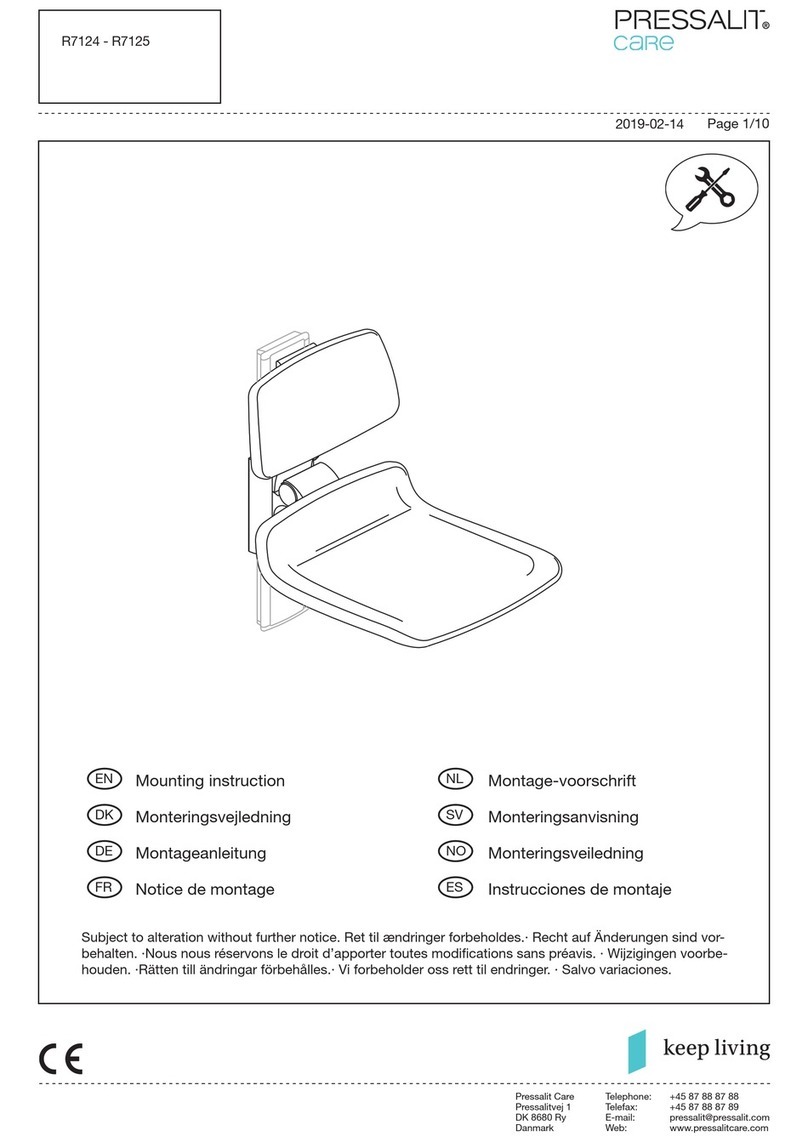
Pressalit Care
Pressalit Care PLUS R7124 Mounting instruction
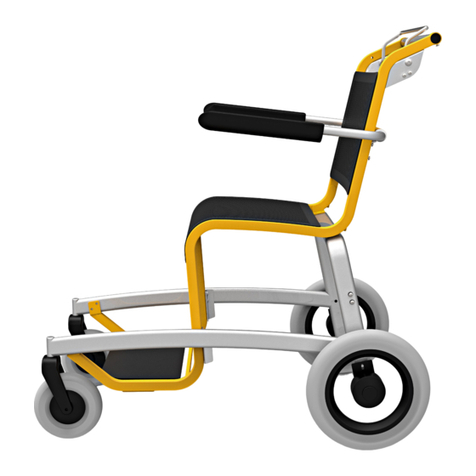
Special mobility
Special mobility Caddy3 user manual
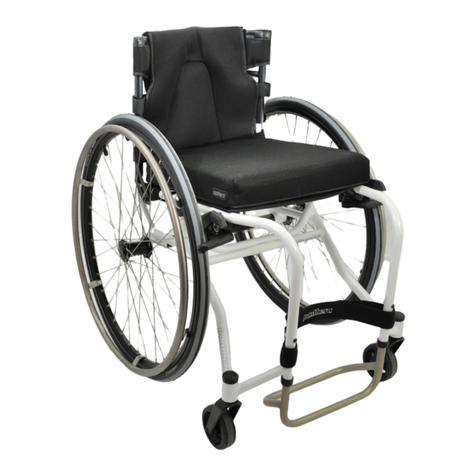
panthera
panthera U3 Light Y-Front operating instructions

Gima
Gima 27708 Use and maintenance book
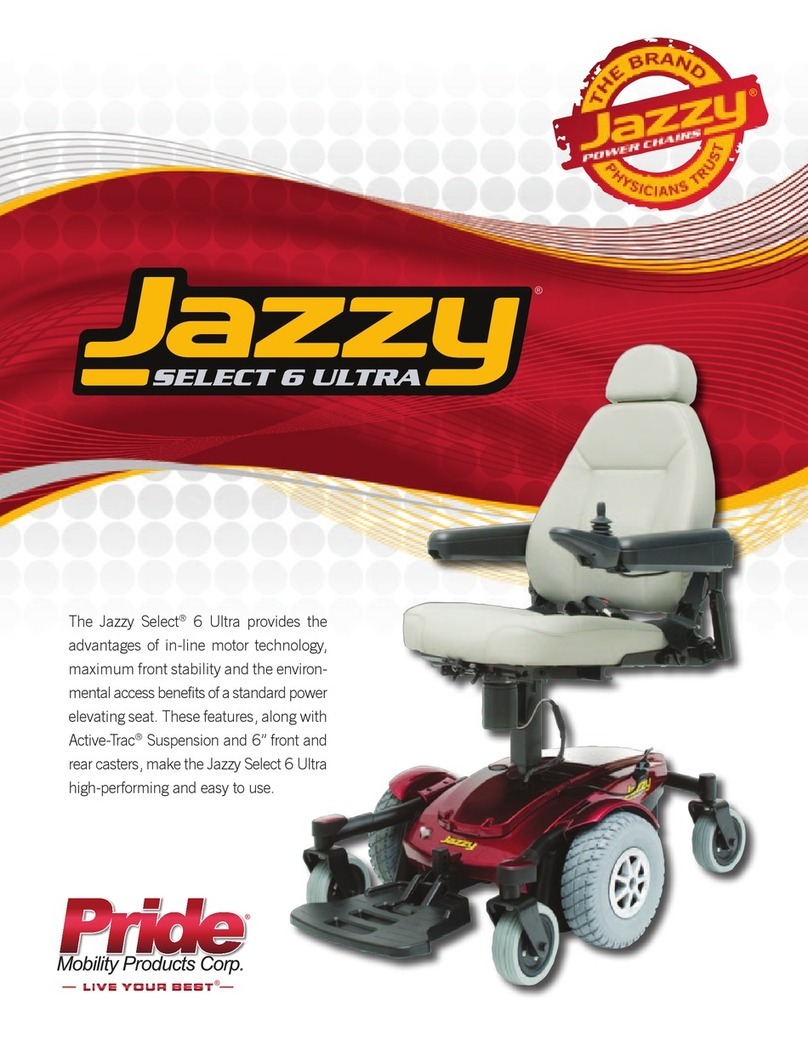
Pride Mobility
Pride Mobility Jazzy Select 6 Ultra PG VR2 Specifications

